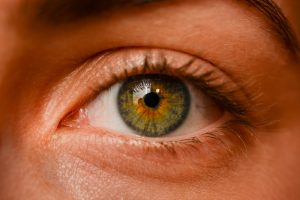Corneal abrasion is an injury to the epithelial surface of the cornea, which causes approximately 10% of visits to the ophthalmic emergency room (1). These common injuries of the eye usually occur as a result of trauma (2).
The cornea
 The cornea is a transparent membrane devoid of vessels, but rich in nerve fibres. It is continuously wetted by the tear film that adheres to its surface. The tear film-corneal surface interface constitutes the most powerful converging lens in the human eye.
The cornea is a transparent membrane devoid of vessels, but rich in nerve fibres. It is continuously wetted by the tear film that adheres to its surface. The tear film-corneal surface interface constitutes the most powerful converging lens in the human eye.
The cornea is about 1 mm thick and consists of five layers from outside to inside:
- a pavimentous (stratified) epithelium,
- Bowman's membrane,
- the stroma,
- Descemet's membrane,
- the endothelium.
Course of corneal abrasions
Corneal abrasions rarely complicate and in most cases resolve completely within a few days (1). However, if the injury is deep, the healing process may take longer and the outcome may be corneal scarring that, in severe cases, may impair vision and require corneal transplantation (2).
Symptoms
Symptoms of corneal abrasion include photophobia, ocular pain, pain in the extraocular muscles, excessive tearing, blepharospasm, feeling of having a foreign body in the eye, blurred vision and headaches.
Diagnosis
The diagnosis of corneal abrasion is confirmed by the ophthalmologist using fluorescein eye staining, which highlights the lesion (2).
Fluorescein test
Fluorescein is a dye that, once introduced into the eye, binds to the corneal stroma, allowing any erosions or corneal ulcers to be detected.
The test is performed by applying a drop of fluorescein solution to the eye and then illuminating the cornea with blue light.
Treatment
The literature suggests different treatment regimes for corneal abrasions and, at present, theeye patchi.e. the eye patch, is the most widely used procedure for the management of this condition, in combination with topical antibiotics, cycloplegics and oral analgesics (1).
These procedures remain widely prescribed even though there is no clear evidence to recommend their use (1). Moreover, the indication for the use of the eye patch is particularly controversial because the bandage reduces oxygenation and increases corneal temperature, increasing the possibility of infection and slowing healing (1).
Xanthan gum and sodium hyaluronate in the treatment of corneal abrasions
Recently, the usefulness of gels based on natural biopolymers has been highlighted xanthan gum and sodium hyaluronate to promote wound healing and prevent eye infections (1). During the wound repair process, the use of a lubricant is always advisable because hydration and lubrication protect the ocular surface from damage due to friction and drying (1).
The gel, based on hyaluronic acid and xanthan gum, is applied in the conjunctival fornix, mixes with the tear and forms a viscous, transparent bandage which, by reducing the friction caused by eye movements and blinking, protects the surface of the eye by promoting the repair processes resulting from wounds or abrasions.
Xanthan gum and sodium hyaluronate
They are high-molecular-weight polysaccharides, capable of binding water molecules and with mucoadhesive properties, providing effective hydration and protection of the cornea. In addition, sodium hyaluronate is well known to promote wound healing as it stimulates the proliferation and migration of epithelial cells (1).
Netilmicin for antibiotic therapy
The xanthan gum and sodium hyaluronate gel can also be enriched with netilmycin, a broad-spectrum, effective, safe and non-cytotoxic aminoglycoside antibiotic that provides good protection against bacterial infection during the wound repair process (1).
Other types of treatment
Since most corneal abrasions heal without significant long-term complications, pain relief is the main issue for the patient (2).
Anti-inflammatory drugs
Non-steroidal anti-inflammatory drugs (NSAIDs), both topical and systemic, can be useful in reducing pain due to corneal abrasions (2).
Antibiotic drugs
Doctors, however, often also recommend prophylactic antibiotic treatment. A concomitant infection of the corneal lesion can, in fact, slow down healing. The use of antibiotics is associated with a lower risk of degeneration of the abrasion into an ocular ulcer (2).
In contact lens wearers, suspension of lens wear is recommended until the corneal abrasion has completely healed (2).
